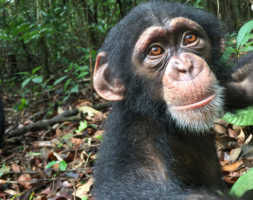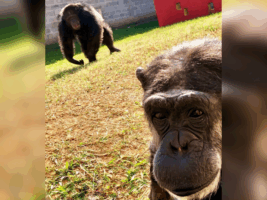Book review – “Trauma in Sentient Beings: Nature, Nurture and Nim” ( by Antonina Anna Scarná and Robert Ingersoll – 2024)

By Alyson Baker*
In their previous book, “Primatology, Ethics and Trauma“, Antonina Anna Scarná and Robert Ingersoll exposed the dark side of the use and treatment of the chimpanzees used in the 1960s/1970s great ape language experiments. They argued, among other things, that the research was fundamentally flawed, and that the chimpanzees all suffered from complex post-traumatic stress disorder. In “Trauma in Sentient Beings”, they expand on their argument that the language research had traumatic impacts on both the chimpanzees and their human researcher-carers, and moreover that such impacts apply to all chimpanzees held in captivity: “Animals born into captivity are born into tragedy.”
Much of the book is a primer on human development – covering all the elements that result in the sense of an experiencing self through time and an associated personality. It discusses character traits and runs through different theories on learning, development, mind creation, and attachment formation. It is impossible, or at least it was for this lay reader, not to do a bit of self-analysis while reading Trauma in Sentient Beings. All this information prepares the reader for considering the plight of the research chimpanzees; even if you already conceptualise chimpanzees as individuals, once you read of the myriad complexities, including intergenerational factors, that go into forming those individuals, you realise the many stresses the chimpanzees must have faced.
The chimpanzees discussed are those at the University of Oklahoma’s Institute for Primate Studies (IPS). They came from various backgrounds, and all would have had character traits and personalities that made them, for example, resilient or fragile, sanguine or despairing. They were taken as infants from their mothers in the wild, were ex-zoo or ex-circus performers, were ex-pets, were purchased from a catalogue, or were born in captivity; “bred for purpose”. Some arrived at the IPS “with their ears pierced and wearing jewellery”. They were all active players in forming attachments, or having difficulty doing so, with the humans they were forced to interact with.
Some of the chimpanzees had been at the IPS before being sent on for research elsewhere, and then returned; Ingersoll about Nim: “He was like the country kid who moved to the big city as a baby, and came back as a teenager.” The movements of the individual chimpanzees described are hard to keep track of, highlighting how disorienting it must have been for the chimpanzees. Some suicided under the weight of their experiences. The changes in their sequential environments could be stark: for example, going from being treated as a child in a family home, with no experience of other chimpanzees, to being confined in a cage and treated the same way as the alien strangers around you.
The chimpanzees had no autonomy or choice; participation in the research was “100% non-negotiable”. Their similarities to humans, the reason for their being the subjects of research, was also the cause of “some unusual and quasi-sadistic situations”, and some questionable behaviours – for example, chimpanzees being given pornographic magazines, or them sharing showers and baths with their human carers. Some of the chimpanzees had over 100 sequential researcher-carers and: “Many of the researchers were psychologically absent. Either because of alcoholism, drugs, and unresolved trauma issues, or were not physically in the same place as their animals.”
The book explains that although chimpanzees and humans share DNA, brain structure, self-awareness, and emotions, they need to be in their natural environments to process information in a way they can overcome the stresses of life. Viktor Frankel’s experiences are related where he observed people in an unconscionable situation (incarceration in a concentration camp in the 2nd World War), holding on to their inner freedom by maintaining their generosity towards other prisoners. The book asks what were the gestures available for the Oklahoma chimpanzees to do the same in a similar situation? They might have become ‘encultured’ through being forced to participate in the language experiments, but that doesn’t mean they could, or would, process information or rationalise their situations the same way a human might.
In some cases, trauma can be beneficial for the positive development of a human subject, but the chimpanzees didn’t have that possibility (I liked that the authors point out that even assuming this is unethical – “since it is not clear that primates have reduced capacity for processing”). What is observable in the relationships between the chimpanzees and their researcher-carers is their “non-linguistic attachment behaviours”. The cover of the book features an image of Nim gently inspecting a deep scratch on Ingersoll’s face, a scratch which Nim had inflicted. There were bi-directional, across species bonds, where not only the chimpanzees but “the human researcher-carers would have brought their own attachment styles into the relationships.”
The book focusses on the relationships between Ingersoll and Nim, Alyse Moore and Lilly, and (as an extension of the arguments) the relationship between Irene Pepperberg and Alex the grey parrot. These relationships are used to discuss the boundaries that were, or weren’t, defined, and whether there is ever an ethical way to carry out research with any sentient being, chimpanzees specifically. The most moving part of the book for me was the reports of all three researchers learning of the deaths of their friend/colleague/research subject. None of the researchers were present at the time of the deaths. These descriptions highlight the enormous impact these relationships had on the humans.
Trauma in Sentient Beings is an important book considering how, if at all, humans can engage with chimpanzees without causing stress or long-term trauma. Examples are given of non-invasive research such as that conducted by Catherine Hobaiter in the Budongo Forest Reserve, Uganda. It also raises the issue of how to deal with trauma in chimpanzees, a necessary concern given the number of chimpanzees still held in captivity – including those in sanctuaries in various countries in Africa for chimpanzees displaced by habitat loss, and the bushmeat and pet trades, and those elsewhere for chimpanzees rescued from research laboratories, zoos, etc. As the authors comment, it is not just about realising all that goes into making us human individuals, it is about how we go about being good human individuals – to learn from our mistakes and to work to ameliorate the consequential damage.
* Alyson Baker lives in Whakatū Nelson, Aotearoa New Zealand. She volunteered at the Ngamba Island Chimpanzee Sanctuary, Uganda in 2017, and returned in 2018 , when she also went chimp tracking in Kibale National Park, and she returned again to Ngamba in 2023. In 2021 Alyson completed an MA looking at our moral responsibilities to chimpanzees and she is currently working on a PhD regarding the moral motivation of those who work on behalf of chimpanzees.

 Español
Español
 Português
Português








